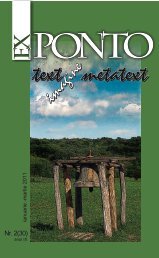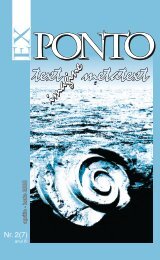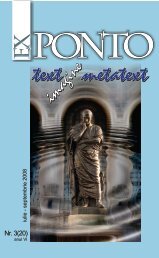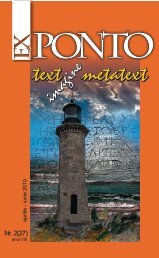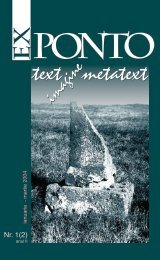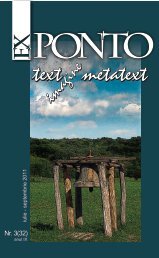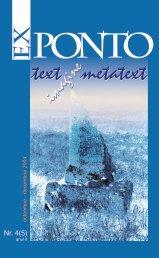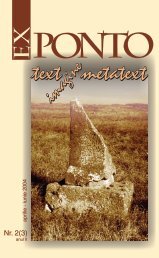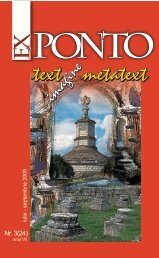versions, even those which contain erroneous emendations or redesign theconcrete appearance of the text, tell the history of its transmission. His study“Information on Information” suggests that different editions have their ownpersonality that bear the marks of their cultural context as they were added tothe text. Obviously, the image of the texts can restore their visual history or,as Michael Warren calls it, the “existential text” (the text as it was presentedto its contemporaries).It seems that McLeod appreciates the concreteness of the literary workand its iconicicty as a substantial compound of the meaning, sometimesexplicitly intended by the author. Lacking their visual context or aspect,literary works become incomplete and consequently, their readers’ responseis partial. In “Editing Shakespeare”, he also suggests that the text is acomplex “simultaneous whole” which consists in “integral units”: type-bytype composition, graphic “restyling” (distortions), errors, fonts, ink etc. Hedoes not seem to believe in corrections that presuppose the annulment ofthe previous editions. Whenever a new edition appears, it supplies anothershape that counts for its own vitality inserting “turbulence in the flow of text.” 8Typographical features of a text may provide the original effervescence ofthe text. The text is “infinitive” or “polymorphous” since it is a sort of endlessmultiple authoritative creation, implying the editorial process, as well. The“infinitive” text consists of the entire set of versions and documents that containfragments that belong to the text. It is historically accurate since it is closer tothe spirit of the era in which the text was created/performed. 9 Thus, authorialintentions are expanded over editorial intensions and cultural pressures.They all make the meaning and the significance of a work, without ignoring,annulling, erasing their forerunners.Editing the Whole Body of the TextText as a Speaking SubjectIn the chapter “From the Speaking Subject to the Inscribed Body”, PatrickFuery reinterprets the dialectic pair absence and presence in Heideggerianterms. He recalls Heidegger’s crossing over the concept of Sein and thephilosopher’s explanation: it does not represent a negation of Being. On thecontrary, the crossing out indicates the “focal point of existence,” which isintended to mark “subjectivity within the qualifying sense of presence.” 10 Hesubstitutes the crossed out Sein with the crossed out Voice in order to positthe speaking subject into a discursive context according to the more generalscheme of the presence and absence interplay. This erasure is a bipolar sign:it means that the crossed out voice is a sign of the speaker’s silent presence,since the voice stands metonymically for the body. On the other hand, it makesobvious its presence both to the speaking individual and to the others, thus itfunctions as a sign of the speaker’s participation in discursive practices.Similarly, Emily Dickinson’s poetics of erasure from the last documentsshe wrote plays a double role: the act of erasing scratches out the writing andthus enforces its presence, or it inscribes its body over the body of writingbecoming a metonymy of the writing. Under such philosophical and textualcircumstances, Dickinson’s fragments contain a dialogic game of the presenceand absence of writing, in which both presence and the crossed out presenceare significant for the concreteness of the text.Ex Ponto nr.3, <strong>2006</strong>83
Marta Werner’s project of editing Emily Dickinson’s Late Papers is aperfect example in this respect. She employs three displays of the sametextual material: facsimiles of the fragments considered relevant for Dickinson’swork, their diplomatic transcriptions, and SGML-marked electronic texts. Shescanned the papers of unexpected and irregular format, which are inscribedwith texts that, according to Werner, cannot be edited without their corporealsupport: pieces of torn paper, envelopes, and drafts of never sent letters.Considering them images of texts readable in electronic media. Werner offers“a series of speculative and fragmentary ‘close-ups’ – a portrait in pieces,a constellation of questions.” 11 Among this disordered mass of documents,she discovers a shift of authorial intentions, more like a continuous processof refining the text through its corporeal suggestions, various placements ondifferent kinds of sheets of paper, or certain pinned gathering, a completelyphysical ordering of the text in sequences. Dickinson’s authorial intentions ofthe 1870s and 1880s focus on the graphematic aspect of text and the way inwhich these signs, letters, stresses, punctuation marks, scratches or cuttingouts, inscribe the text by their immediate presence. There is no “definitivetext:” it is no longer the last, ultimate, absolute, definitive, holy, sacred, perfect,accurate, legible work, but a provocative visual-textual body in search of itsproper multiplier. The epoch in which Dickinson bound her poems is far behind.Every gesture of the poet and every detail of her utensils and supports countas textual interventions and, consequently, produce text: random letters, linesover a text, cancellations in ink, become the unusual setting of her writing. Therichness of all these metatextual events raises the legitimate question: “Howcan an editor preserve their contribution to the text and make the text legible,process which would suppose the separation of the text from its significantcontext?” Since Marta Werner comes to the conclusion that there is no finalintention expressed by these fragments, she finds a convenient editorialsolution to present the images of the fragments as they are (as facsimiles inher books or scanned images on her website) and add her commentaries asnecessary guidance/directions in the textual labyrinth.In “Writing’s Other Scenes,” Marta Werner draws attention to the“mutilations” of the text or “textual wounds” that are abundant in Dickinson’smanuscripts. They are not simply erasures, which mark the change of initialauthorial intentions; they are part of the text that should be displayed, textthat requires the dialogical presence of writing and its crossing out. Studyingthe multiple ways of annulling the text, Werner reaches a double typology oferasure: cancellation, which corresponds to the more profound process ofself-censorship, and scratching, cutting out, striking out, which correspondto spontaneous authorial decisions. Irrespective of the critics’ classifications,“Dickinson’s crossing and re-crossing of her poem manuscripts show us thatpoems are articulated in a space that has no intention to maintain originalintegrity.” <strong>12</strong>Ex Ponto nr.3, <strong>2006</strong>84Problematic Use of Erasures in Editing Authorial IntentionsThomas Tanselle assumes a commonsense perspective on the authorialintentions and the way in which they should be brought out during the editorialprocess. Authorial intentions are synonymous with the intended meaning andbecome the objective of the science of interpretation. Tanselle differentiatesbetween authorial alterations and alterations made by others. Although he
- Page 2 and 3:
Ex PontoText/imAgine/metatextNr. 3
- Page 4 and 5:
SUMAR♦EditorialOVIDIU DUNĂREANU
- Page 6 and 7:
editorialOVIDIU DUNĂREANUScriitoru
- Page 8 and 9:
poezieIULIA PANĂ* * *Cum ar trebui
- Page 10 and 11:
* * *m-am trezit în astă diminea
- Page 12 and 13:
IOAN ŢEPELEAPoemele mirării care
- Page 14 and 15:
Mona Lisa pare a acoperi chiar şoc
- Page 16 and 17:
în schimb, asfaltul te dinamizeaz
- Page 18 and 19:
în care ai putea să îţi întinz
- Page 20 and 21:
Un ins orbecăia ca în visOchii -
- Page 22 and 23:
Şi în secunda următoareSă apar
- Page 24 and 25:
CLAUDIA VOICULESCURondeluriDoar ste
- Page 26 and 27:
OLIMPIU VLADIMIROVMulţumireTrec nu
- Page 28 and 29:
prozăFLORIN ŞLAPACO teribilă set
- Page 30 and 31:
Ah, a zis Aloisius, ia uite-l şi p
- Page 32 and 33:
viaţa multor fiinţe zaharisite, a
- Page 34 and 35:
crede în ce facem noi. Apoi, câte
- Page 36 and 37:
- Dar sensibiloasă mai eşti, se s
- Page 38 and 39:
publicul avizat (şi nu numai) al u
- Page 40 and 41: Din somn mă scoală-n miez denoapt
- Page 42 and 43: Lumina cunoştinţii să-i facă ar
- Page 44 and 45: memorialisticăPERICLE MARTINESCUPa
- Page 46 and 47: asta este şi drama ţării mele, a
- Page 48 and 49: provocând pagube importante, deşi
- Page 50 and 51: formidabil, într-adevăr: nouă bo
- Page 52 and 53: 11 iulie Mâine dimineaţă plec la
- Page 54 and 55: locul lor, tejgheaua şi rafturile
- Page 56 and 57: cărui frunze fâşâiau în vânt
- Page 58 and 59: originalul de lângă mine - la sca
- Page 60 and 61: traduceri din literatura românăIL
- Page 62 and 63: Rituella fête met cet être en tra
- Page 64 and 65: elogios, recunoaşterea unanimă. P
- Page 66 and 67: Furtuni înnebunind azurul, scutur
- Page 68 and 69: Mă voi înzdrăveni cu mei proasp
- Page 70 and 71: Cu suflu-i arzător crăpând buzel
- Page 72 and 73: Marin Gherasim - Diptic, 1994, ulei
- Page 74 and 75: IIIMarin Gherasim - Kairos, 2001, t
- Page 76 and 77: Marin Gherasim - Aripă, 2000,ulei
- Page 78 and 79: imagineMarin GherasimUn spirit inte
- Page 80 and 81: Retrospectivă la Muzeul Naţional
- Page 82 and 83: invitat „ex ponto”CARMEN CHIHAI
- Page 84 and 85: vine din povestea lor. Or, noi avem
- Page 86 and 87: Paradoxically, the myth of the unfo
- Page 88 and 89: validate or invalidate the choices,
- Page 92 and 93: tries to separate the editor’s do
- Page 94 and 95: ConclusionFrom the Platonic myth of
- Page 96 and 97: Fractalul este foarte aproape de pe
- Page 98 and 99: Conceptul de text matricial (aplica
- Page 100 and 101: Proximităţi şi diferenţe, unele
- Page 102 and 103: Citit retrospectiv, Ionescu nimere
- Page 104 and 105: avangardaPAUL CERNATÎntre extremel
- Page 106 and 107: Cu relativă simpatie „revoluţio
- Page 108 and 109: cu un cuprinzător eseu al d-lui Ni
- Page 110 and 111: *În paginile revistei Integral nu
- Page 112 and 113: la „stânga plasticei şi a liris
- Page 114 and 115: geri a separării dintre artistic
- Page 116 and 117: dar cu apucături de satir. Lukrezz
- Page 118 and 119: participa direct la strălucirea su
- Page 120 and 121: situaţii politice, a bravat fără
- Page 122 and 123: Portretul de anarhist, pe care şi-
- Page 125 and 126: Poate nu întâmplător, cel care-i
- Page 127 and 128: mari scriitori români contemporani
- Page 129 and 130: se uite la foaia de/ Hârtie, care-
- Page 131 and 132: la recensământ.)/ -Pe-astea să l
- Page 133 and 134: (…)// Peste câţiva ani/ A înce
- Page 135 and 136: Ex Ponto nr.3, 2006baston, indifere
- Page 137 and 138: cronica literarăNICOLAE ROTUNDCons
- Page 139 and 140: Ex Ponto nr.3, 2006comentează în
- Page 141 and 142:
priveam pe furiş maxilarele descă
- Page 143 and 144:
Ex Ponto nr.3, 2006Nicolae Motoc pr
- Page 145 and 146:
VALERIA MANTA TĂICUŢURăpit pe ve
- Page 147 and 148:
Apelul la miturile precreştine est
- Page 149 and 150:
Ex Ponto nr.3, 2006şi scadenţa M(
- Page 151 and 152:
Ex Ponto nr.3, 2006cel al gepidei A
- Page 153 and 154:
Ex Ponto nr.3, 2006lizare discursiv
- Page 155 and 156:
Ex Ponto nr.3, 2006decât necesară
- Page 157 and 158:
Ex Ponto nr.3, 2006‹‹cochilie
- Page 159 and 160:
cronica literaturii străineADINA V
- Page 161 and 162:
Ex Ponto nr.3, 2006Titlul romanul a
- Page 163 and 164:
de a-l găsi pe cel care a salvat-o
- Page 165 and 166:
Ex Ponto nr.3, 2006158aservirii rus
- Page 167 and 168:
În mitul grec, odată cu suveranit
- Page 169 and 170:
Ex Ponto nr.3, 2006162nu e conţinu
- Page 171 and 172:
Un fenomen care pare pur occidental
- Page 173 and 174:
studii culturaleMARCOS FARIAS-FERRE
- Page 175 and 176:
Ex Ponto nr.3, 2006assume meaning i
- Page 177 and 178:
Ex Ponto nr.3, 2006in rapid transit
- Page 179 and 180:
Ex Ponto nr.3, 2006contingency of t
- Page 181 and 182:
production about the ‘internation
- Page 183 and 184:
Ex Ponto nr.3, 2006Dar peripeţiile
- Page 185 and 186:
Ex Ponto nr.3, 2006(24 dec. 1672 -
- Page 187 and 188:
Ex Ponto nr.3, 20061705, ambii ai P
- Page 189 and 190:
Ex Ponto nr.3, 2006Constantin Brân
- Page 191 and 192:
Ex Ponto nr.3, 2006‘separatist’
- Page 193 and 194:
Ex Ponto nr.3, 2006succedea pe tron
- Page 195 and 196:
al XVII-lea - pentru a ne limita do
- Page 197 and 198:
41Arhimandritul Neofit a ocupat fun
- Page 199 and 200:
o imagine cuprinzătoare a contribu
- Page 201 and 202:
Ex Ponto nr.3, 2006Din subcapitolul
- Page 203 and 204:
Ex Ponto nr.3, 2006Din primul studi
- Page 205 and 206:
să devină fiinţe sociale, căci
- Page 207 and 208:
sociologia cărţiiCONSTANTIN CIORO
- Page 209 and 210:
în biblioteci. Cronicarii literari
- Page 211 and 212:
Ex Ponto nr.3, 2006Lui Debussy îi
- Page 213 and 214:
Ex Ponto nr.3, 2006cumente preţioa
- Page 215 and 216:
Salonul Internaţional de carte „
- Page 217 and 218:
Ex Ponto nr.3, 2006scriitorii înş




